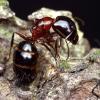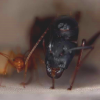Gnamptogenys triangularis is an Ectatommine species that is native to most of the South American continent. They were first introduced to the southeast US likely in the 1980s and they've been quietly spreading ever since. They are growing more and more common in Mississippi, Alabama, and Florida and are millipede-hunting specialists.
On August 21, 2018, I moved my dogs' water bowl and this queen came running out from underneath it. I've never seen males or workers of this species around my area so it was a complete surprise to me that I found her right in my backyard.
She is about 6 millimeters.




I put her in a test tube with some eco earth substrate, connected to a small outworld. Apparently most of the new world Gnamptogenys are specialist predators while the ones native to Asia are generalists. I figured I would have to feed this queen millipedes for her to survive. I found a millipede for her and she accepted it.
After a few days I decided to give her a mealworm. They can't be that much different from millipedes, right? These ants just drink the hemolymph. I checked the next day and she had dragged the mealworm closer to her and piled dirt around it, which probably meant she at least consumed some of it.
On September 6, I was happy to see that she laid an egg.

Then I put two cricket legs in her test tube. At this point I just disconnected the outworld because she wasn't using it at all. She is quite inactive and rarely leaves her eggs, even when I check on her. After a few hours I checked to see her absolutely destroying one of the cricket legs, clearly enjoying it.
It is awesome that they actually accept more food than just millipedes. Maybe the species had to learn to adapt to a wider diet in order to thrive in their nonnative habitat.
Here she is on September 7 with her second egg.


She kept laying a new egg every day for the next few days after that.
September 14, 2018
Today, she has what looks like five eggs. It is hard to tell because she used the eco earth to make a little wall.



Edited by Aaron567, September 11 2021 - 10:50 AM.
















































